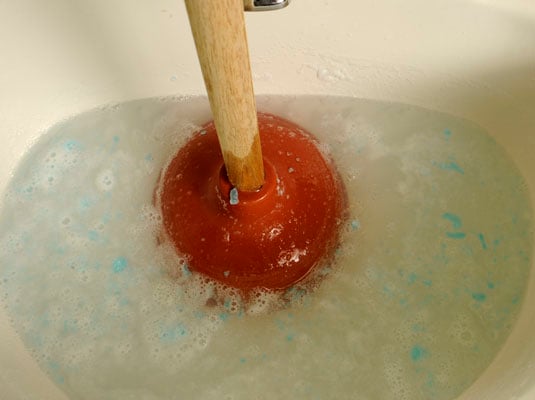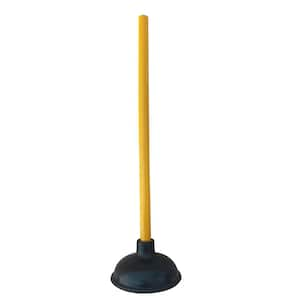Perfecting Plunger and Drain Cleaners: Professional Strategies
Perfecting Plunger and Drain Cleaners: Professional Strategies
Blog Article
What are your beliefs on How to Use a Plunger to Unclog a Toilet or Drain?

Intro
Appropriate upkeep of house drains pipes is important for avoiding blockages and guaranteeing smooth water flow. One of the key devices in every home owner's toolkit is the bettor, together with various drainpipe cleaners developed to tackle persistent blockages efficiently. This article discovers exactly how to use bettors and drain cleansers successfully to keep your drains pipes flowing openly.
Section 1: Recognizing Plungers
Kinds of Plungers
There are several sorts of plungers readily available, each created for various types of drains and blocks. One of the most typical types include mug bettors, flange bettors, and accordion bettors.
How Plungers Work
Bettors work on the principle of creating pressure and suction to remove obstructions. When correctly used over a drainpipe, they develop a vacuum cleaner that can take out debris or break up blockages.
Selecting the Right Plunger
Choosing the best plunger relies on the sort of drainpipe and the nature of the obstruction. Mug bettors are ideal for sinks and tubs, while flange bettors are much better fit for bathrooms because of their style.
Common Mistakes with Bettors
Staying clear of these mistakes makes sure efficient plunging: incorrect seal around the drain, insufficient force, and unclear surrounding debris.
Area 2: Making Use Of Plungers Properly
Prep work
Before plunging, make sure the bettor covers the drain completely and creates a limited seal. Clear any type of noticeable debris around the drain opening.
Method
Start with gentle plunging activities to develop suction. Increase stress gradually, making use of a constant rhythm. Repeat as essential up until the drain clears.
Fixing Tips
If diving doesn't function, try changing the seal, applying petroleum jelly for a far better seal, or using a different type of plunger.
Section 3: Understanding Drainpipe Cleaners
Kinds Of Drain Cleaners
Drain pipes cleaners can be chemical or enzymatic. Chemical cleansers utilize strong chemicals to dissolve blockages, while enzymatic cleaners make use of all-natural enzymes to break down organic matter.
How Drainpipe Cleansers Work
Chemical cleansers respond with clogs to liquify them, while enzymatic cleansers break down natural materials like hair and oil without damaging pipes.
Safety Factors to consider
Always put on handwear covers and eye defense when utilizing chemical drain cleaners. Guarantee adequate air flow and follow maker instructions thoroughly.
Eco-Friendly Alternatives
Think about utilizing vinegar and cooking soft drink or enzyme-based cleansers for environmentally friendly options that are more secure for pipelines and the atmosphere.
Area 4: Using Drain Cleaners Efficiently
Application Methods
Pour chemical cleaners straight right into the drainpipe opening. Enable them to benefit the advised time before purging with warm water. Enzymatic cleansers ought to sit over night.
Preventative measures
Stay clear of mixing different types of cleaners, as this can create hazardous fumes. Never ever make use of chemical cleansers together with a plunger, as splashing can take place.
Handling Persistent Blockages
For consistent obstructions, consider utilizing a pipes snake or calling an expert plumber to avoid damages to pipelines.
Verdict
In conclusion, comprehending exactly how to utilize plungers and drainpipe cleaners successfully is essential for keeping healthy and balanced pipes systems. By picking the right devices and strategies, home owners can take on small blockages and protect against significant pipes problems down the line.
How to Use a Plunger to Unclog a Drain
The humble plunger is a simple yet effective tool for breaking clogs in sinks, tubs and toilets. This handy tool is easy to use. You can make the most of its power if you understand how it works. Ready to dive in? Here’s what you need to know.
Safety First!
Never use a plunger with drain chemicals. Water will splash as you work, and the chemicals can spatter, burning skin and eyes. It’s a good idea to use rubber gloves and wear safety goggles when you work on a clog.
Choose the Right Tool for the Job
Plungers come in two different styles. Sinks, bathtubs and showers require a cup plunger. Like its name suggests, the rubber end is shaped like a cup. Use a flange plunger on toilets. These plungers have a rubber funnel extending from the cup. A plunger needs to be big enough to cover the drain.
Ready, Set, Plunge!
Coat the rim: Coat the plunger rim with petroleum jelly. This helps make a better seal.
Block outlets: Hold a wet rag over nearby outlets such as the overflow vent or the drain in a second sink.
Release air: Insert the plunger at an angle into the water. Water will displace air in the cup. A water-filled cup is more forceful than one filled with air.
Keep the plunger upright: Hold the plunger perpendicular to the drain. Use fast, forceful strokes, but make the first stroke gentle. The first stroke can create a splash if the cup still contains air. Thrust the plunger 15 to 20 times.
Snap off the plunger: The final stroke should be a strong upward motion that ends when the plunger snaps off the drain.
Repeat the process: you may need to repeat this sequence several times. When the water drains away, your work is done. High-five! https://plumbernw.com/blog/how-to-use-a-plunger-to-unclog-a-drain/

Application Methods
Pour chemical cleaners straight right into the drainpipe opening. Enable them to benefit the advised time before purging with warm water. Enzymatic cleansers ought to sit over night.
Preventative measures
Stay clear of mixing different types of cleaners, as this can create hazardous fumes. Never ever make use of chemical cleansers together with a plunger, as splashing can take place.
Handling Persistent Blockages
For consistent obstructions, consider utilizing a pipes snake or calling an expert plumber to avoid damages to pipelines.
Verdict
In conclusion, comprehending exactly how to utilize plungers and drainpipe cleaners successfully is essential for keeping healthy and balanced pipes systems. By picking the right devices and strategies, home owners can take on small blockages and protect against significant pipes problems down the line.
How to Use a Plunger to Unclog a Drain
The humble plunger is a simple yet effective tool for breaking clogs in sinks, tubs and toilets. This handy tool is easy to use. You can make the most of its power if you understand how it works. Ready to dive in? Here’s what you need to know.
Safety First!
Never use a plunger with drain chemicals. Water will splash as you work, and the chemicals can spatter, burning skin and eyes. It’s a good idea to use rubber gloves and wear safety goggles when you work on a clog.
Choose the Right Tool for the Job
Plungers come in two different styles. Sinks, bathtubs and showers require a cup plunger. Like its name suggests, the rubber end is shaped like a cup. Use a flange plunger on toilets. These plungers have a rubber funnel extending from the cup. A plunger needs to be big enough to cover the drain.
Ready, Set, Plunge!
Coat the rim: Coat the plunger rim with petroleum jelly. This helps make a better seal. Block outlets: Hold a wet rag over nearby outlets such as the overflow vent or the drain in a second sink. Release air: Insert the plunger at an angle into the water. Water will displace air in the cup. A water-filled cup is more forceful than one filled with air. Keep the plunger upright: Hold the plunger perpendicular to the drain. Use fast, forceful strokes, but make the first stroke gentle. The first stroke can create a splash if the cup still contains air. Thrust the plunger 15 to 20 times. Snap off the plunger: The final stroke should be a strong upward motion that ends when the plunger snaps off the drain. Repeat the process: you may need to repeat this sequence several times. When the water drains away, your work is done. High-five! https://plumbernw.com/blog/how-to-use-a-plunger-to-unclog-a-drain/

I discovered that review about How To Use Your Toilet Plunger Correctly in 5 Easy Steps when doing a search on the search engines. Are you aware of anybody else who is fascinated with How to Unclog Your Sink with a Plunger? Do not hesitate to share it. Thanks so much for your time invested reading it.
Get Started Report this page